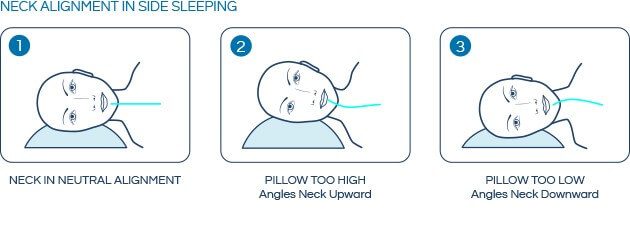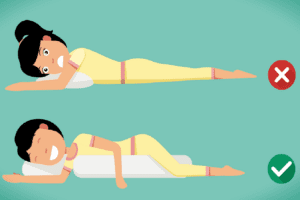I am a VERY untidy sleeper—arms and legs everywhere. I personally prefer a firm feather pillow that I can punch into shape around my neck. My wife prefers a softer contoured “Wave Pillow”. Some people prefer a Memory Pillow.
An average Adult head weights between 5-7kgs and it’s the head that need supporting as well as the neck. The horizontal distance between the neck and the tip of the shoulder should also be measured. That should be the MAXIMUM height of the pillow. Anything higher pushes your neck into side flexion. The neck should be as horizontal as possible while sleeping.

*Shutterstock diagram
Table of Contents
ToggleThe 3 main types of pillow materials
Feather and down these pillows are usually made from a combination of the two materials – the more down, the more expensive. A higher percentage of down means a softer pillow that will last longer, and they can be moulded and fluffed into your favourite shape. On the downside, they can be quite expensive, and are a potential allergen. Lifespan: 2-5 years.
Foam can be made to measure, keeps its shape for years and is hypoallergenic, so it’s a great option if you suffer from allergies or asthma. “Memory foam” pillows, made from NASA-designed visco-elastic polyurethane, mould to your body shape and relieve pressure on sensitive areas, but may make it difficult to move about so they may not be the best choice for a restless sleeper. Lifespan: 2-5 years.
Latex A renewable and biodegradable product made from the sap of a rubber tree. Latex pillows are durable and last for years before needing replacing, and they have the added benefit of being hypoallergenic. Latex comes in a variety of shapes, profiles and densities. Lifespan: 2-5 years
Sleeping Position
I always advice my patients NOT to sleep on their stomachs if possible. On your tummy you have to turn your head to breathe, it’s like looking over your shoulder for hours on end. Also your mid-section sags downwards putting pressure on low back postural muscles and discs.

*Diagram courtesy Virginia Pelley LifeHacker July 2016
A recent study by Adelaide physiotherapists* used 99 patients with chronic neck pain. They were all Side Sleepers. The parameters checked were the degree of night pain, degree of waking pain and the quality of sleep obtained. The conclusions drawn from the study were that:
- Latex pillow is likely to provide the most support and best value
- The shape of the pillow made no difference to waking pain or abolition of night pain.
- The contour pillow was less comfortable & provided poorer quality sleep.
- The feather pillow was a consistent poor performer in all outcome measures
- The latex pillow performed consistently well & was a better performer than the subject’s own pillow in all outcome measures.
* Reference: Gordon, S et al (2009) Pillow use: the behaviour of cervical pain, sleep quality and pillow comfort in side sleepers. Manual Therapy, 14, 6, 671-678
Ashton Lucas
Principal Physiotherapist



